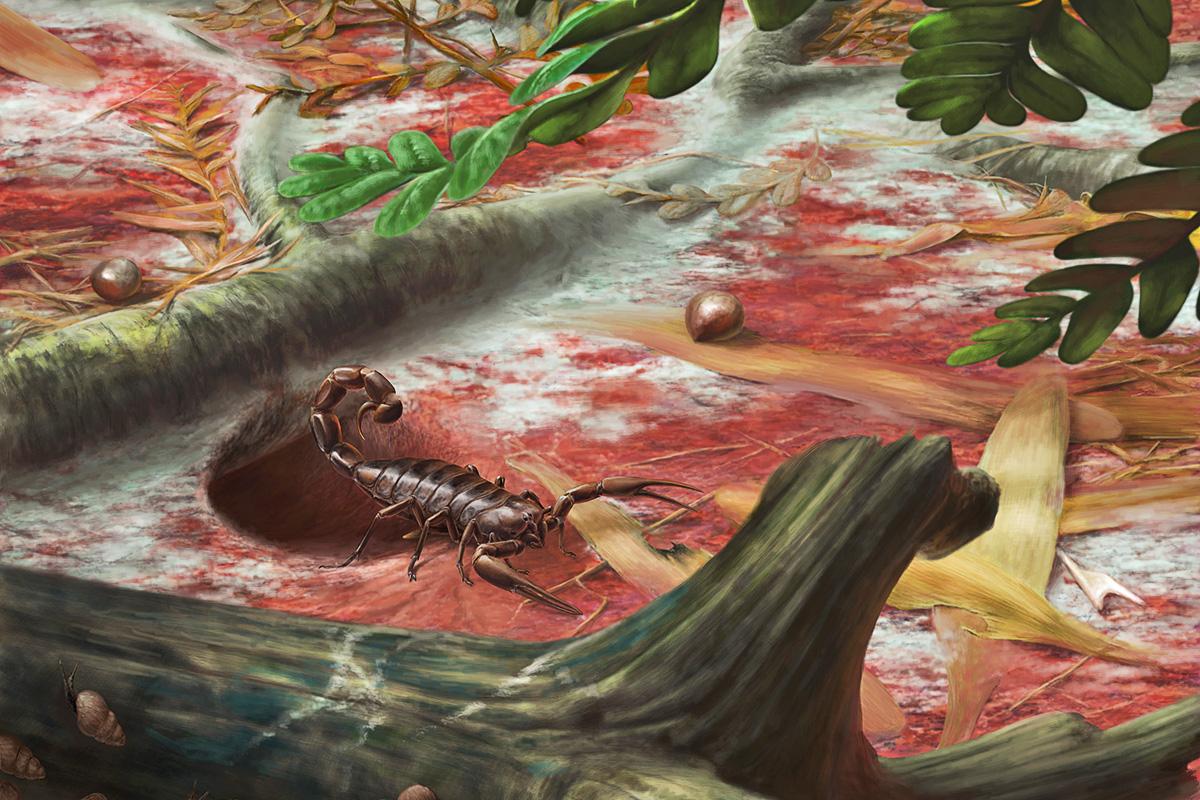A research team from Germany, England and the USA led by Jason Dunlop from the Museum für Naturkunde Berlin published in the international journal BMC Evolutionary Biology the first well-preserved fossils of scorpions from the Permian period. These come from the 291 million year old Petrified Forest of Chemnitz, Germany. These ancient scorpions reveal a mixture of primitive and advanced features and, significantly, are preserved within their original habitat. Most fossils of land-living animals are based on individuals which fell into (or were washed into) bodies of water. The Petrified Forest of Chemnitz preserves plants and animals in more or less their original position; the organisms having been killed instantly by a volcanic eruption. The two best preserved scorpions are probably a male and a female – perhaps even a mating pair – and there is good evidence that they were preserved within their original burrows under tree roots.
About 2000 living species of scorpions are known, as well as over 130 extinct fossil species. Many of these fossils come from the Carboniferous period (ca. 299 to 359 million years ago), but no complete scorpion fossils were previously known from the next period: the Permian (ca. 252 to 299 million years ago). A new species, Opsieobuthus tungeri, was described from a remarkable 291 million year old fossil locality in Saxony: the Petrified Forest of Chemnitz. The two best preserved fossils appear to represent a male and a female and were informally named ‘Jogi’ and ‘Birgit’ respectively.
The Chemnitz fossils belong to a scorpion genus previously known from the Carboniferous. The end of the Carboniferous was an interesting time for scorpion evolution as it seems that both primitive and modern-looking species lived side-by-side. The Chemnitz fossils still show several primitive features, such as the position of the eyes, and suggest that in the Permian some of these more primitive forms still survived alongside those scorpions which eventually gave rise to living species. In other words, there was a long overlap during which primitive and modern scorpions existed at the same time.
The Chemnitz fossils preserve comb-like sensory organs called pectines on the underside of the body. In modern scorpions these organs help males ‘sniff out’ chemical traces from females, thus the male pectine is subtly different in shape from the female one. We see this in the new fossils too, which is good evidence that we have both sexes. The sediments surrounding the scorpion fossils also suggest that the fossils were preserved in their life position, even to the point of being within their original burrows beneath tree roots. Modern scorpions often inhabit similar burrows today. Intriguingly, discovering a male and female fossil scorpion in their original life position – about two metres apart from one another – could even indicate that ‘Jogi’ and ‘Birgit’ were a mating pair; preserved for ever in their adjacent burrows by a volcanic explosion of ash.
Published in: Dunlop, J. A., Legg, D. A., Selden, P. A., Fet, V., Schneider, J. W. & Rößler, R. 2016. Permian scorpions from the Petrified Forest of Chemnitz, Germany. – BMC Evoutionary Biology 103:11. DOI 10.1186/s12862-016-0634-z
embarged until 7.th April, 01:00 BST):
http://bmcevolbiol.biomedcentral.com/articles/10.1186/s12862-016-0634-z
Pictures for free you can get here:
http://download.naturkundemuseum-berlin.de/presse/PermianScorpion
1: Scorpion fossil, Ronny Rößler, Chemnitz
2: Discovery site, Volker Annacker, Chemnitz
3: Reconstruction: Jason Dunlop, Berlin
4: Original habitat: Frederik Spindler, Chemnitz
